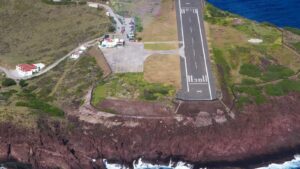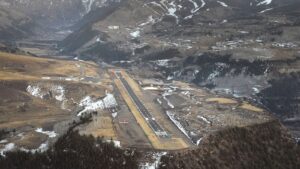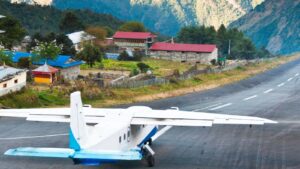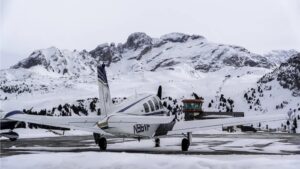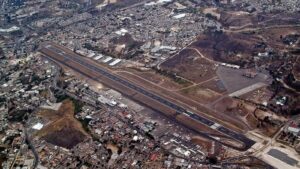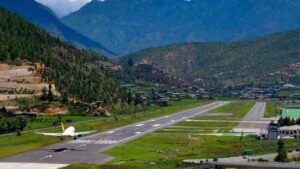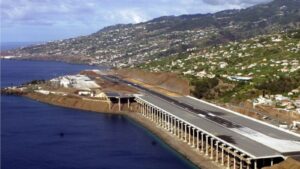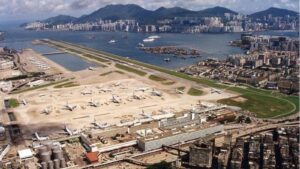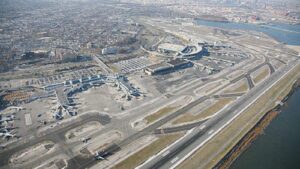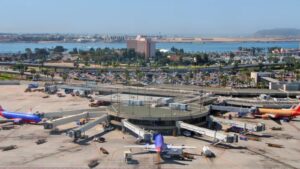Extremely Dangerous Airports in the World Will Blow Your Mind
Summary
Top 20 Extremely Dangerous Airports in the World Will Blow Your Mind. Although flying is one of the safest means of travel, many passengers suffer from a fear of flying. Some airport approaches are a lot more challenging than others […]
Top 20 Extremely Dangerous Airports in the World Will Blow Your Mind. Although flying is one of the safest means of travel, many passengers suffer from a fear of flying. Some airport approaches are a lot more challenging than others and can turn into a terrifying experience ever. From iced runways to tabletop landings, here are Top 20 Extremely Dangerous Airports in the World.
Video: Extremely Dangerous Airports in the World Will Blow Your Mind
Saba Airport
Juancho E. Yrausquin Airport, otherwise known as Saba Airlines, is one of the world’s scariest airports in aviation history. Located on the Dutch Caribbean island of Saba, it lies about 27 miles south of St. Maarten. Its runway is a pitiful 1300 feet long, making it one of the shortest commercial airports in the world. This tiny runway length means only the very best pilots have what it takes to safely land and take off from it. But its short runway is not the only hazard would-be approaching pilots need to be aware of. The airport is surrounded by jagged terrain and a sharp left bank immediately before landing.
Video: Extremely Dangerous Airports in the World Will Blow Your Mind
Congonhas Airport
Congonhas International Airport in São Paulo, Brazil, is not only scary, it is also one of the world’s most dangerous airports. Another airport with a short runway, it is also located in a heavily built-up portion of the enormous city. It feels as if you’re scraping the tops of high-rise buildings as you land here. One of four airports serving the city, it has become famed for its risky runways that are often accused of being the slipperiest in the world because its runway had not been constructed with proper grooves to drain away excess rainwater, leading to a build-up of standing water at times.
Telluride Regional Airport
Telluride Regional Airport is located in southwest Colorado and is widely considered one of the scariest in the world. Around 5 miles west of the town of Telluride, it is one of the highest airports by elevation in America, at 9,070 feet. It was built in the 1980s and boasted over 9,400 operations a year. While actually quite safe in reality, the approach to it can seem quite hair-raising, to say the least. Located on a small plateau, it features 1,000-foot sheer cliffs at both ends of the runway.
Svalbard Airport
Built on permafrost, Svalbard Airport not only seems scary and the worst, but it is also an engineering marvel in its own right. Located in Norway’s Arctic Archipelago, the 8,000-foot runway is built directly on ice. Culverts under the runways allow water to run from the mountain. There are also no runway lights, so flights are only permitted during daylight. This may not seem like a big issue until you realize that in the winter the sun does not really rise here. The airport was built on permafrost with the runway insulated against the ground so it will not melt during the summer.
Wellington International Airport
Located in New Zealand, Wellington International Airport is yet another of the world’s most difficult airports to land at. Featuring a 6,350 feet long runway, both ends appear to start and end in water. Approaching it is also very tricky for pilots, as the airport is located in a mountainous area of the country which is famed for its gusty winds, which make maneuvering for landings even more tricky. Even after landing, passengers can be swept off their feet by the strong gusts. Despite this, there have been very few safety incidents.
Gisborne Airport
Another entry from New Zealand, Gisborne Airport is also considered to be one of the world’s most difficult airports for airplane landing and takeoff both. Located on the outskirts of Gisborne, this airport actually has a railway intersecting its runway at one point. It has three grass runways and one main runway, landings require accurate coordination with approaching trains. For this reason, it is not uncommon for either planes or trains to be delayed to allow the other to safely pass.
Lukla Airport
The Lukla Airport, technically Tenzing–Hillary Airport, in Nepal serves as the main airport for those visiting Mt. Everest. Part of what makes this airport so difficult to land on is the way it is nestled in between mountains, and the incredibly short length of the runway. In fact, the airport is quite small. The airport sometimes loses electric power, cutting off communication with the controllers. This makes landings risky even in perfect conditions. The airport is positioned 9,325 feet high and is built on the side of a mountain.
Courchevel International Airport
Video of a landing at the Courchevel airport went viral a few years ago, as it has one of the shortest runways of any airport in the world, at 1,722. Not only this, but the paved runway has a downward slope of 18.5% which makes taking off even more difficult. To add to the already difficult landing, the runway is built right into the Alps, where pilots have to fly through a narrow valley even to prepare for descent. Only specially-certified pilots are allowed to land here.
Toncontin Airport
As you may have noticed, airports located in the mountains are very hard to land on, due to their varying terrain and often short approaches. Toncontin Airport is no different. In order for planes to prepare for the descent, they must make a rapid 45-degree bank turn to reach the runway in a valley, an approach likened to landing on an aircraft carrier. After this bank, planes must rapidly drop in altitude, being careful not to scrape the terrain directly underneath. Wind gusts and poor weather also hamper the approach.
Princess Juliana International Airport
Like some other runways in the Caribbean Sea, Princess Juliana Airport, located in Saint Maarten, is perhaps the most famous on the list. This is partly because of the public beach situated just before the runway. Planes must approach over the water at an extremely low altitude. This often results in large and loud gusts of wind and sand engulfing those enjoying the crystal blue water down below. For the pilots, however, bothering visitors is not the only worry. Princess Juliana was initially built for smaller planes, but the booming tourist industry has brought A340s and 747s into the regular traffic rotation.
Read More: Top 30 Flight Secrets That Are Never Told to Passengers
Paro Airport
It is famous for being one of the world’s most difficult to land at. In fact, only a handful of pilots are qualified to do so. Located in Bhutan, the airport lies about 1.5 miles above sea level. Sounds pleasant enough, but be mindful that the airport is surrounded by sharp peaks, up to 18,000 feet tall. Its runway is 6,500 feet long and only allows for arrivals and departures during the daytime. The most difficult part is that pilots cannot see the runway at all until the last minute, as they must maneuver between mountains at a 45-degree angle before finally dropping quickly onto the runway.
Gibraltar International Airport
Gibraltar International Airport is probably the most unusual airport in southern Europe. While the runway isn’t particularly hard to land at, an interesting design feature makes it potentially dangerous. The city’s main street, Winston Churchill Avenue, intersects with the runway and has to be closed when a plane needs to land. There is a stoplight on the road reporting cars to stop, but there have been a number of close calls in the airport’s history. The short runway also ends abruptly at the sea on both ends, forcing pilots to stop very quickly immediately after landing.
McMurdo Air Station
Not many people travel to Antarctica, which means that the airport infrastructure there is significantly lacking. This runway isn’t particularly short, but it is built on “white ice,” which can make for a difficult landing, even in good weather conditions. In 1970, the Airbus C-121 slid off the runway and still sits off to its side, buried in snow. During the winter, the area is dark 24 hours a day. The airport has no lights on the runway, and during the non-infrequent whiteouts, pilots must land blind, using night vision equipment.
Madeira Airport
Madeira Airport is one of the few in the world where engineers built a platform in order to expand the runway. The landing strip sits between steep cliffs and the shores of the ocean. To expand the runway, engineers built a series of platforms on an artificial island. The runway is held up by more than 180 columns, which have to withstand the shock of landings. Only a limited number of pilots are qualified to land at this airport. Pilots must navigate their approach by spotting landmarks and cannot land by instrument alone.
MCAS Futenma, Okinawa
This airport is situated on a US Marine Corps Air Station in Okinawa, Japan. The airstrip is located right in the middle of a crowded city, with houses, parks, schools, and businesses crowding right up to the fence. It is also a busy airport, as F/A-18 Hornets and V-22 Osprey continuously land here. In fact, the situation of MCAS Futenma is in direct violation of the safety standards set down for military airfields by the U.S. Department of the Navy. In 2003, it was recommended that the Navy shut down the airport, but it remained open and in 2004 a CH 53 Sea Stallion crashed into one of the school buildings on the nearby campus of Okinawa International University.
Narsarsuaq Airport
Similar to Antarctica, the extreme airports in Greenland are often covered in ice. At only 5,900 feet in length and canvassed in smooth ice, this runway is difficult for pilots. The weather is also often stormy, creating intense turbulence and low visibility on approach, making it very uncomfortable for both flight crew and passengers. Wind shears affect planes, which, coupled with the icy runway, can direct them off their course. Oh, and the nearby active volcano also occasionally erupts, sending ash into the clouds, which can stall and destroy engines.
Kai Tak Airport, Hong Kong
Although this dangerous airport has now closed, it will forever be remembered as one of the most dangerous in the world. Surrounded by high-rise buildings, planes approaching the runway would have to make several complex turns to be in position for landing. The maneuver became known in the piloting community as the “Hong Kong Turn” and as the “Kai Tak Heart Attack” amongst passengers. Kai Tak Airport was the international airport of Hong Kong from 1925 until 1998. Officially known as Hong Kong International Airport from 1954 to 6 July 1998.
LaGuardia Airport, New York
Although not as visually terrifying as some of the other airports in this list, the hazards at LaGuardia Airport involve crowded airspace, bird wildlife, and a runway that extends into the water. On January 15, 2009, US Airways Flight 1549 landed in the Hudson River after losing both engines due to multiple bird strikes. Fortunately, all 150 passengers were successfully evacuated from the plane. LaGuardia Airport is an airport in Queens, New York. The airport is the third busiest airport serving New York City, which covers 680 acres.
San Diego Airport, California
Pilots have to be especially skilled to fly into this busy airport that is surrounded by mountains and strong tailwinds blowing in from the west. On September 25, 1978, a Boeing 727-200 collided in mid-air with a Cessna 172 while attempting to land at San Diego Airport. All 137 passengers lost their lives along with 7 people on the ground. San Diego International Airport, formerly known as Lindbergh Field, is an international airport 3 mi northwest of downtown San Diego, California, United States. It is owned and operated by the San Diego County Regional Airport Authority.
Read More: Unusual People in the World
Barra International Airport
Also known as Barra Eollgary Airport, the Barra International Airport is situated in Scotland at the northernmost tip of the Barra Island at the bay of Traigh Mhòr. With only three runways, Barra Airport is one of the only places in the world where flights take off from a sand beach. Signs marking the area as a part of the airport keep visitors from spreading out their blankets and getting smashed by an ascending plane, but the real danger of Barra Airport is for the airplanes. Carefully monitoring the wind and the tides, airport officials will only use the runway when they are sure it won’t be overrun by the sea.
Which is the most dangerous airport? Have you ever traveled to any of these airports? Share your thoughts in the comment section.
